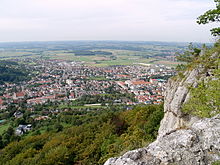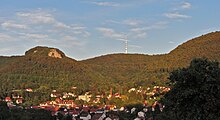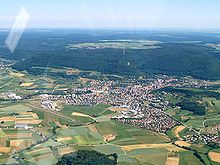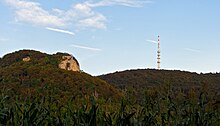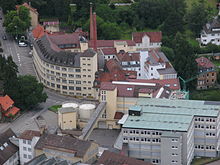Heubach
| coat of arms | Germany map | |
|---|---|---|
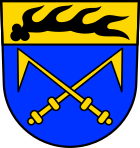
|
Coordinates: 48 ° 47 ' N , 9 ° 56' E |
|
| Basic data | ||
| State : | Baden-Württemberg | |
| Administrative region : | Stuttgart | |
| County : | Ostalbkreis | |
| Height : | 466 m above sea level NHN | |
| Area : | 25.81 km 2 | |
| Residents: | 9774 (Dec. 31, 2018) | |
| Population density : | 379 inhabitants per km 2 | |
| Postal code : | 73540 | |
| Area code : | 07173 | |
| License plate : | AA, GD | |
| Community key : | 08 1 36 028 | |
| City structure: | 2 districts | |
City administration address : |
Hauptstrasse 53 73540 Heubach |
|
| Website : | ||
| Mayor : | Frederick Brütting ( SPD ) | |
| Location of the city of Heubach in the Ostalb district | ||
Heubach is a town in the Ostalbkreis in Baden-Württemberg . It belongs to the East Wuerttemberg region and the edge zone of the European metropolitan region of Stuttgart .
geography
Geographical location
Heubach lies on the edge of the Remstal and at the foot of the Rosenstein ( Swabian Alb ), between Schwäbisch Gmünd and Aalen . The Klotzbach crosses Heubach from south to north.
The city borders in the north on Böbingen an der Rems and Mögglingen , in the east on Essingen , in the south on Bartholomä and in the west on the city of Schwäbisch Gmünd .
City structure
In addition to Heubach, six other villages, farms and houses belong to the town of Heubach with the formerly independent community of Lautern. The town of Heubach within the boundaries of 1970 includes the town of Heubach, the districts of Beuren and Buch and the houses of Himmelreich and Jägerhaus, as well as the abandoned village of Eckelhofen. The Lautern district and the Ölmühle homestead belong to the former municipality of Lautern .
Division of space

According to data from the State Statistical Office , as of 2014.
District of Buch
The hamlet of Buch was first mentioned in a document on October 6, 1356. The Rechberg , Gmünder Bürger, the Hl.-Geist-Spital and the Augustinian Monastery of Gmünd , the Woellwarth and the parish of St. Ulrich zu Heubach appear in Buch as landlords and local lords . In 1528 the local rulers agreed on a contract regarding their rights. The chapel, built in 1519, fell victim to the construction of Bucher Hauptstrasse. A new chapel was built, which houses a richly designed winged altar from 1522 from the old chapel. Village life is shaped by the very active sports and village community of Buch, which in 1990, in cooperation with the city of Heubach, set up the multifunctional meeting place “Bucher Dorfschenke”.
Lautern suburb
The suburb of Lautern is embedded in the upstream mountains of the Eastern Alb along the Lauter that gives it its name . Lautern is known as the “gardener's village” with its twelve horticultural businesses and a large tree nursery. Until the municipality reform in 1971, Lautern was an independent municipality. The mayor is Bernhard Deininger. In Lautern there is a very active village community with many associations and a Catholic parish. Particularly noteworthy is the Lautern youth initiative, “JIL” for short. In 2012 Lautern was awarded the silver medal of the state competition “Our village has a future”. Since the anniversary "650 years Lautern" in 1995, a historical market has been held every four years under the motto "Lautern anno 1900", which each time attracts around 20,000 visitors.
history
Until the 16th century
The oldest traces of settlement in the urban area of Heubach date from the late 13th or early 12th millennium BC. The age of a bone bullet tip found in the “Kleine Scheuer” cave has been dated to 14,000 years. This makes Heubach the oldest documented settlement in the entire Ostalb district.
Ceramic finds, ramparts and barrows on the Rosenstein, Hoch- and Mittelberg indicate a settlement by settled parts of the population between 800 and 400 BC. Further finds of iron implements suggest that the ramparts on the Rosenstein were reused as a refuge by the Alemannic population in the period from the 3rd to the 5th century AD. A mansion in the area of the Heubacher Castle and Ulrichskirche can be assumed from around the year 700.
In 1234 Heubach was first mentioned in a document in connection with a knight Hainricus de Hôbach. The Rosenstein castle ruins are located on the Rosenstein and were first mentioned in 1282. At the end of the 13th century, Heubach and the Rosenstein came into the possession of the Counts of Oettingen , who pledged the property to the Counts of Württemberg around 1358 . The city charter has Heubach since 1334. After the victory of Emperor Charles IV. Against the Wuerttemberg Count Eberhard the Greiner fell Heubach and Rosenstein in 1360 to the Kingdom of Bohemia , went in 1377 but again as security stem ownership of Württemberg over that with the possession by 1413 Men von Woellwarth enfeoffed. Georg von Woellwarth left Rosenstein Castle in 1524 and built a castle in Heubach.
Württemberg time
In 1579, Duke Ludwig von Württemberg bought Heubach and Rosenstein back and made Heubach an official town. In 1581 a town hall was built. In the Thirty Years' War the population sank to 10 people, but the town was quickly rebuilt and repopulated due to the efforts of the Württemberg government.
The Oberamt Heubach existed from the 18th century and was merged with the Oberamt Gmünd on April 25, 1807 when the new administrative structure was implemented in the Kingdom of Württemberg , which was founded in 1806 .
The opening of the Remsbahn by the Württemberg State Railways in 1861 gave access to a modern means of transport via the nearby railway station in Unterböbingen , but the city did not get its own railway station until 1972, when the Unterböbingen – Heubach branch line opened was shut down.
A total of 72 Heubach citizens died in the First World War .
Nazi era
A local branch of the NSDAP was founded in Heubach as early as 1932 . In the Reichstag election of March 5, 1933 , the NSDAP in Heubach received 55.4% (nationwide: 43.9%) of the valid votes, whereas the center with 20.1% (nationwide: 14.0%) and the SPD with 5 , 4% (nationwide: 18.3%) with a high voter turnout (90.3%). In a unanimous decision of Heubach Municipal Council of 22 March 1933 to the Chancellor Adolf Hitler and the Reich President Paul von Hindenburg each honorary citizenship one - the city of Heubach then trend following - have been awarded after the end of the Nazi dictatorship in each case has been withdrawn has been.
With the administrative reforms during the Nazi era in Württemberg , the Oberamt became the district of Gmünd in 1934 and the newly defined district of Schwäbisch Gmünd in 1938 , to which Heubach has belonged since then. In the referendum on the head of state on August 19, 1934 - Reich President Paul von Hindenburg died at the age of 86 at the beginning of August 1934 - 1,599 of 1,670 eligible voters cast their votes. 97.3% (nationwide: 89.9%) voted for the merging of the office of the Reich President with that of the Reich Chancellor and 2.1% (nationwide: 10.1%) against.
From May 1, 1935, the former sub-communities Beuren, Buch and Heubach formed one community. Wilhelm Gayer was Mayor of Heubach from March 1, 1939 until his entry into the Wehrmacht at the end of 1943. Then city architect Mangold was appointed acting mayor. Deputy mayor at that time was Wilhelm Braun.
On March 16, 1944, there was an aerial battle between the German destroyer squadron 76 and a US bomber unit over the area around Heubach. 26 German interceptors were shot down, ten crash landings and three American B-17 bombers crashed between Heubach and Mögglingen . The deceased crews were buried in the cemetery in Heubach and later transferred to a military cemetery.
The city of Heubach played a key role in the German defense of the Albaufgang. As a result of the military's refusal to surrender peacefully, which was temporarily enforced by the SS with the threat of armed violence, shortly before the end of World War II , Heubach was removed from the US on April 23 and on the night of April 24, 1945 -american artillery was fired at from the direction of Igginger Höhe and Mögglingen. A total of five people were killed and three Heubacher were injured, some seriously. Many residents then took refuge in air raid tunnels around the Rosenstein and on the sand as well as to Beuren. Here, however, some " werewolves " had retired in their youth, who fanatically wanted to take up the hopeless fight against the advancing US troops. A 15-year-old member of the Werwolf organization died as part of these retreat battles.
On April 22, 1945 the Volkssturm Heubach was set in motion in the direction of Ulm . Since the acting mayor Mangold was badly injured in the leg by a shrapnel on the evening of April 23, 1945 and was guarded by members of the SS , the deputy mayor Wilhelm Braun secured the early morning of April 24, 1945 - after the Wehrmacht had finally withdrawn peaceful surrender of the city to the Allies . Heubach narrowly escaped the threat of bombing by the US air forces that had already been requested and were in the air . On the morning of Tuesday, April 24, 1945, at around 10:00 a.m., Heubach was captured and liberated by US troops under hoisted white flags with the help of four tanks from the 10th US Panzer Division coming from Böbinger Strasse . Through Beuren and over the Bargauer Kreuz, the US troops then moved on to the Alb highlands in the direction of Ulm.
post war period
As part of the American occupation zone , the city of Heubach belonged to the newly founded state of Württemberg-Baden from September 19, 1945 , which was merged into the current state of Baden-Württemberg in 1952 .
The district reform in 1973 added the city to the new Ostalb district . Between 1982 and 1983, the Rodelwiesen building area was opened up and the redevelopment of the town center began. Heubach celebrated its 750th anniversary a year later. In 1998, 2003 and 2008 the city received the award for children and youth-friendly cities in the Ostalb district . 2013 followed the award of residence for specialists and executives . In 2014 the Jägerstrasse II building area was realized.
Incorporations
As part of the regional reform , the previously independent municipality of Lautern was incorporated on January 1, 1971 .
Religions
In addition to the Protestant St. Ulrich Church and the Roman Catholic St. Bernhard Church, Heubach also has an Evangelical Free Church , a Jehovah's Witness community and the Ulu Mosque of the Turkish-Islamic Cultural Association Heubach und Umgebung eV
politics
mayor
With the election of the mayor on October 9, 2011, the lawyer Frederick Brütting ( SPD ) was elected as the successor to the outgoing mayor Klaus Maier ( SPD ) with seven opposing candidates in the first ballot with 67.3% of the votes and a turnout of 57.1% .
With a turnout of 33.1% and an opposing candidate, Frederick Brütting was confirmed in his office by the election of the mayor on October 20, 2019 in the first ballot with 95.6% of the valid votes. He is also chairman of the Rosenstein administrative association and a member of the district council of the Ostalb district.
Deputy mayors of the city of Heubach are currently the city councilors Karl Grötzinger (list of citizens) and Gerhard Kuhn (independent citizens), and the city councilor Julia Gaiser ( CDU ) is the deputy mayor .
Municipal council
From the constituent meeting after the local elections on May 25, 2014 to July 16, 2019, the Heubach municipal council had 23 members as chairperson, in addition to the mayor, whose term of office is basically five years. Until July 16, 2019, the seats were distributed among the individual parties and electoral groups as follows (the changes relate to the result of the election in 2009):
| fraction | Election result | ± | Strength | ± |
|---|---|---|---|---|
| CDU | 34.1% | −3.2 pp | 8 seats | ± 0 |
| Independent Citizens (UB) (a) | 29.1% | +29.1 pp | 7 seats | +7 |
| Citizens' List (BL) | 27.5% | −6.2 pp | 6 seats | −2 |
| SPD (b) | 9.3% | −19.7 pp | 2 seats | −4 |
After the local elections on May 26, 2019 , the incumbent municipal council was constituted on July 16, 2019. A number of long-term city councils were passed. Erich Blum (UB), for example, left after a total of 20 years of membership in the Heubach municipal council, Bernhard Deininger (CDU) after a total of 35 years, Roland Hegele (CDU) after a total of 29 years, Ellen Renz (CDU) after a total of 25 -year of membership as well as Marie-Luise Zürn-Frey (CDU) after a total of 15 years of membership from the committee.
Since the local elections on May 26, 2019, the municipal council of the city of Heubach has had 22 members in addition to the mayor as chairman. The seats are distributed among the individual parties and electoral groups as follows (the changes relate to the result of the election in 2014):
| fraction | Election result | ± | Strength | ± |
|---|---|---|---|---|
| Citizens' List (BL) | 32.4% | +4.9 pp | 7 seats | +1 |
| Independent Citizens (UB) | 32.0% | +2.9 pp | 7 seats | ± 0 |
| CDU | 26.0% | −8.1 pp | 6 seats | −2 |
| SPD | 9.5% | +0.2 pp | 2 seats | ± 0 |
coat of arms
The blazon of the coat of arms of the city of Heubach reads: "Under a golden shield head , inside a black deer pole, in blue two diagonally crossed golden hay-ears (hay hooks)."
Administrative community
Heubach is the seat of the administrative community Rosenstein, to which the communities Bartholomä , Böbingen an der Rems , Heuchlingen and Mögglingen belong. The administrative community Rosenstein takes on tasks for the member communities such as budget and tax transactions with tax matters, cash and invoicing transactions, but also the publication of the common official gazette. The chairman of the association is the mayor of the city of Heubach. The board of directors is made up of the mayors of the member communities. The community or city councils send representatives elected from among their number to the association assembly.
Town twinning
Heubach maintains partnership relationships with the following cities:
-
 Laxou in France , since 1964
Laxou in France , since 1964 -
 Waidhofen an der Thaya in Austria , since 1982
Waidhofen an der Thaya in Austria , since 1982 -
 Lauscha in Thuringia , since 1990
Lauscha in Thuringia , since 1990 -
 Anderamboukane in Mali , since 2008
Anderamboukane in Mali , since 2008
Laxou (France)
On January 22, 1963, Federal Chancellor Konrad Adenauer and French President Charles de Gaulle signed the Franco-German friendship treaty . In the same year the first contacts between Heubach and Laxou began near Nancy in Lorraine . On September 26, 1964, the city friendship certificate was signed at a festive event. The euro Council awarded in 1976 the two cities, the high honor of the Flag of Honor of Europe in recognition of their outstanding achievements for international understanding . Numerous contacts and friendships have emerged over the last few decades. The 50th anniversary was celebrated in Heubach in 2014.
Waidhofen an der Thaya (Austria)
In 1982, Heubach came into contact with the Austrian municipality of Waidhofen an der Thaya (near the Czech border) through connections between displaced citizens . On May 15, 1982 this partnership was sealed with a sisterhood certificate.
Lauscha (Thuringia)
The city of Heubach sealed its third partnership on September 1, 1990 in Heubach, initiated by the longstanding contacts between the evangelical parish and the glassblowing town of Lauscha in the former GDR . The partnership document was countersigned on October 3, 1990, the day of reunification , in Lauscha.
Anderamboukane (Mali)
Anderamboukane is located in the southeast of Mali , near the border with Niger . The population is approx. 26,000, the municipal area approx. 9,000 km² (Baden-Württemberg 35,751.46 km²). The municipal council consists of 23 members, meetings take place every three months. Mainly Tuareg live in Anderamboukane .
Many of them are employed as cattle breeders (donkeys, goats, camels, sheep and cattle), mainly millet and beans. Fish farming also plays a role thanks to the adjacent pond. Artisans make goods from silver, wood, iron and animal skins. The natural foundations such as the nature of the soil, weather and topography are extremely unfavorable. The advancement of the desert endangers the livelihood of the inhabitants. The whole country is very dependent on the rain, because the food source consists of their own harvest. Failure to rain has serious consequences.
Heubach's French twin town Laxou established contacts with Anderamboukane as early as 2000 . In the meantime, some projects have been funded and also implemented on site. The city of Heubach and its citizens support the people in Anderamboukane in the school system, health sector, in agriculture and in daily life. The projects are organized and supported by the residents of Anderamboukanes themselves. The city of Heubach has set up a donation account for Anderamboukane at Raiffeisenbank Rosenstein and Kreissparkasse Ostalb .
On New Year's Day in 2015, Mayor Aroudeiny Ag Hamatou was so badly injured in a rebel attack that he died two days later. Heubach mourned with his twin town.
Culture and sights
Heubach is located on the Swabian Alb North Edge Path , a long-distance hiking trail that leads past many sights. In addition, the Way of St. James leads through the Heubach urban area.
Museums
In cooperation with the companies Triumph International and SUSA, the Heimat- und Miedermuseum was established in 1974 in Heubach Castle , which is still the only museum of its kind in Germany.
In Heubacher police station is the Police Museum , which has emerged from a private collection of a police officer. Objects from the local police force have been exhibited there since 1853. The museum opens by appointment.
Buildings and sights
An ensemble of several half-timbered buildings forms the town center of Heubach. Worth seeing are the town hall from 1581, the market fountain from 1777, the block tower from 1473, a gate tower of the once walled churchyard, as well as the Protestant town church from 1581. It was originally a Romanesque basilica with a painted passion cycle. The Woellwarthsche castle building from 1524 was extensively renovated in the 1990s. With its art treasures and as a building, it is one of the most distinctive structures in Heubach. The building houses the city library and the local history and corsetry museum . Since December 2008 the historic classroom has been located in the knight's hall of the Heubach Castle .
The Heubach telecommunications tower , which is 142 meters high, is located on the Glasenberg. In addition to antennas for broadcasting television and radio programs, it also has a viewing platform that is only open to visitors from time to time.
The Evangelical parish hall with glass work by Albrecht Pfister is also remarkable.
Rosenstein
The Rosenstein is striking for Heubach with its Rosenstein castle ruins and its many caves towering over the town .
Regular events
Since 1984 the festival " Free and Outside " has been held annually in July in the position below the rose stone . It is organized and carried out by many volunteers. Camping was possible on a soccer field. In 2009 the festival took place for the last time in 25 years. Since 2012 the association QLTourRaum has been organizing the New Pig Festival in the position instead. In addition, the group organizes the winter festival “Free and Inside” in the Übelmesser club center.
The annual Heubacher mountain bike festival "Bike the Rock" began in 2001 as a hobby mountain bike race. Just three years later, a Bundesliga race in the highest classification, E1 status, was held. The event grew year after year and in 2006 it was awarded Horse Class (HC) status by the UCI International Bike Association . In the area of cross country, races in the hobby and license area continue to take place. Also in 2006 the trial discipline was introduced at “Bike the Rock”. The "European Trial Contest" has been an integral part of the festival since 2011 and some world records have already been set for the Guinness Book. In 2007 the downhill hobby race was introduced. In 2016, the bike marathon was introduced for amateur athletes. In that year the kids race took place for the first time, in which the kindergartens could compete in a relay race.
The traditional children's festival takes place every three years in Heubach in June or July, most recently on July 2, 2016. The Heubach students move in a pageant from the so-called position over the Pionierweg up to the children's festival area between the Glasenberg and the Heidenburren. The first children's festival took place in 1820 under the name Maienfest.
In addition to the children's festival, there is another highlight in summer for the little Heubacher: every year the position is transformed into the play town “Kidstown” for two weeks. Here the children can try out different professions, choose their own local council and mayor. Together they can then pass laws that apply to the children and their carers. The first Kidstown took place in 1999.
The Heubacher Stadtfest (formerly: street festival) takes place annually in summer with fireworks in the evening.
The Water-with-Taste Festival is an annual festival for electronic music in Heubach, which was created in 2013 on the initiative of local young people and developed into one of the largest electronic music festivals in southern Germany with 2200 visitors by 2015.
Economy and Infrastructure
traffic
Heubach is a bit off the main traffic routes, but the neighboring towns of Böbingen an der Rems and Mögglingen can be reached both with the Remsbahn (hourly connection to Stuttgart and Aalen ) and via federal road 29 . The direct road connection from Schwäbisch Gmünd to Heidenheim an der Brenz runs through Heubach .
From 1920 to 1975 Heubach had a railway connection to Böbingen an der Rems to the Remsbahn through the Heubachbahn . Passenger traffic ceased on October 1, 1972 and freight traffic in 1975.
Heubach is connected to local public transport via the city bus of the city of Schwäbisch Gmünd ( Stadtbus Gmünd ).
In the north of the city is the Heubach airfield .
Established businesses
SUSA-Vertriebs-GmbH + Co was founded on March 1st, 1859 by Gottfried Schneider. Corsetry, lingerie and swimwear are still produced and sold at the headquarters in Heubach.
Triumph International was founded in 1886 by Johann Gottfried Spießhofer and Michael Braun as Spießhofer & Braun in Heubach. The manufacturer of women's and men's underwear, leisurewear and home clothing is now active worldwide and is still based in Heubach, but the corporate headquarters of the still family-owned company has been in Bad Zurzach , Switzerland , since 1977 .
The development of the deer brewery is closely linked to the history of the town of Heubach . Chroniclers trace their origins back to around 1600, but there is documentary evidence that the "oldest brewery" was allowed to brew and serve beer until 1725, but only on May 2nd of the same year the concession for the shield tavern with the sign "Zum Hirsch “Was awarded. At that time, the Jakob Hornegger family owned the Hirsch brewery. In 1874 Leonhard Johann Mayer took over the Heubacher brewery, which has been family-owned ever since.
education
Heubach there with the Schiller school, a primary and secondary school with Werkrealschule , also a junior high school that Rosenstein-Gymnasium and the Mörike school, a special school . Another elementary school is located in the Lautern district. Three Roman Catholic , two Protestant and three municipal kindergartens , including a nature kindergarten , complete the educational offer.
The East Wuerttemberg written material archive in the Lautern district is of national importance. It is considered the largest private literary archive in Germany.
There is also the Rosenstein youth music school, an institution of the Rosenstein administrative association based in Heubach. It was founded in 1974. Young musicians trained here have already been successful several times in the national and state competitions "Jugend musiziert".
Others
In 1981 the theater and comedy group Die kleine Tierschau was founded in Heubach by school friends Michael Gaedt, Michael Schulig and Ernst Mantel .
The local name for the citizens of Heubach is "Mondstupfler". This goes back to an old legend of the city of Heubach, according to which the Heubach people climbed the Rosenstein at night many years ago to fetch the moon from the sky with long poles. In the coat of arms of the Woellwarths , who formerly ruled the area, there is a white crescent moon on a red background. A connection between this family coat of arms and the name “Mondstupfer” is suspected, but cannot be proven beyond doubt.
Honorary citizen of the city of Heubach
- Eduard-Hermann Ströle (1821–1896), honorary citizen in 1894 for his services during 26 years as a teacher and as a board member of the gymnastics club
- Theodor Viktor Jäger (1840–1924), honorary citizen in 1900 for his services as a city pastor for many years
- Julius Schneider (1862–1923), honorary citizen in 1920 for his services as an entrepreneur for Schneider & Sohn AG (SUSA-Vertriebs-GmbH + Co) and for his efforts to connect the railway with the Heubachbahn
- Franz Keller (1852–1938), honorary citizen in 1927 for his services in over 50 years as a doctor and promoter of tourism
- Michael Braun (1866–1954), honorary citizen in 1936 for his services as an entrepreneur and co-founder of the Spießhofer & Braun company
- Fritz Spießhofer (1886–1968), honorary citizen in 1954 for his services as an entrepreneur and friend and promoter of culture and associations
- Dieter Braun, honorary citizen 2011
- Günther Spiesshofer (1936–2013), honorary citizen 2011 for his services as partner and former managing partner of Triumph International Spiesshofer & Braun KG
- Gerhard Kolb, honorary citizen 2010 in recognition of his services as an honorary city archivist
- Herta Hörmann (1910–1993), honorary citizen for her services as an entrepreneur at SUSA-Vertriebs-GmbH + Co
- Klaus Maier (* 1956), honorary citizen 2019 for his services as mayor of the city of Heubach from 1986 to 2011
Honorary citizen of the Lautern community
- Alois Dangelmaier (1889–1978), honorary citizen 1967 on the occasion of his services and his 50th anniversary as a priest
sons and daughters of the town
- Johann Michael Braun (1866–1954), entrepreneur
- Walter Gröner (* 1950), writer
- Max Schiefele, alias "Maxxess" (* 1962), electronic rock musician
- Stefan Hering (* 1972), film and television director
- Max Heinzelmann (1990-2017), German poker player
literature
- Friedrich Schenk (Red.): Heubach and Rosenstein Castle. History, tradition, landscape . Published by the city of Heubach. Einhorn-Verlag, Schwäbisch Gmünd 1984 ISBN 3-921703-57-3 .
Web links
swell
- ↑ State Statistical Office Baden-Württemberg - Population by nationality and gender on December 31, 2018 (CSV file) ( help on this ).
- ^ The state of Baden-Württemberg. Official description by district and municipality. Volume IV: Stuttgart district, Franconian and East Württemberg regional associations. Kohlhammer, Stuttgart 1980, ISBN 3-17-005708-1 , pp. 722-726.
- ↑ State Statistical Office, area since 1988 according to actual use for Heubach.
- ↑ Ute Knöpfle: Heubach - City under the Rosenstein. City administration Heubach, 2009, p. 82.
- ↑ Ute Knöpfle: Heubach - City under the Rosenstein. Heubach City Administration, 2009, p. 84.
- ^ Local councils . City of Heubach, accessed on August 9, 2016 .
- ^ Association search of the city of Heubach. Retrieved August 9, 2016 .
- ↑ Lautern receives silver in the competition “Our village has a future” and has developed sustainable ideas. In: remszeitung.de , September 15, 2012, accessed on August 2, 2016.
- ↑ Ute Knöpfle: Heubach - City under the Rosenstein. City administration Heubach, 2009, p. 99.
- ↑ Heubach oldest settlement in the Ostalb district. (No longer available online.) May 22, 2016, archived from the original on August 2, 2016 ; accessed on May 22, 2016 . Info: The archive link was inserted automatically and has not yet been checked. Please check the original and archive link according to the instructions and then remove this notice.
- ↑ Heubach oldest settlement in the Ostalb district. May 20, 2016. Retrieved May 25, 2016 .
- ↑ Ute Knöpfle: Heubach city under the Rosenstein . Ed .: City Administration Heubach. Heubach 2009, ISBN 978-3-00-028108-2 , pp. 6-7 .
- ↑ heubach.de ( Memento of the original from April 27, 2009 in the Internet Archive ) Info: The archive link was inserted automatically and has not yet been checked. Please check the original and archive link according to the instructions and then remove this notice.
- ↑ a b c d e f g Friedrich Schenk et al .: Heubach and Rosenstein Castle . Ed .: City of Heubach. 1st edition. Einhorn-Verlag Eduard Dietenberger GmbH, Schwäbisch Gmünd 1984, ISBN 3-921703-57-3 , p. 236 .
- ^ Walter Wörz, Manfred Schmidtke: The end of the Second World War under Rosenstein . Ed .: History and Local History Association Böbingen. March 2016, p. 18 .
- ^ Walter Wörz, Manfred Schmidtke: The end of the Second World War under Rosenstein . Ed .: Geschichts- und Heimatverein Böbingen eV p. 91 .
- ^ Gerhard Kolb: Heubach in old views . Ed .: European Library - Zaltbommel / Netherlands. Heubach 1990, ISBN 90-288-4905-X .
- ^ Walter Wörz, Manfred Schmidtke: The end of the Second World War under Rosenstein . Ed .: Geschichts- und Heimatverein Böbingen eV 1st edition. S. 77 .
- ↑ Dwight D. Eisenhower: Proclamation No. 2. Landesgeschichtliches Informationssystem Hessen (LAGIS), accessed on November 26, 2019 .
- ↑ http://heubach.de/,Lde/start/heubach/chronik.html Chronicle of Heubach
- ^ Federal Statistical Office (ed.): Historical municipality directory for the Federal Republic of Germany. Name, border and key number changes in municipalities, counties and administrative districts from May 27, 1970 to December 31, 1982 . W. Kohlhammer, Stuttgart / Mainz 1983, ISBN 3-17-003263-1 , p. 455 .
- ↑ Looking for a mosque. Retrieved May 22, 2016 .
- ↑ Churches. City of Heubach, accessed on August 9, 2016 .
- ↑ City of Heubach: Public announcement of the approved applications for the election of the mayor on October 20, 2019. September 27, 2019, accessed November 19, 2019 .
- ^ City of Heubach: Public announcement of the result of the election of the mayor on October 20, 2019. October 25, 2019, accessed November 19, 2019 .
- ^ City of Heubach: career and activities of the mayor Frederick Brütting. Retrieved November 19, 2019 .
- ↑ City of Heubach: Invitation and meeting templates for the constituent meeting of the municipal council on July 16, 2019. In: www.heubach.de. City of Heubach, accessed on July 20, 2019 .
- ^ VG Rosenstein. City of Heubach, accessed on August 9, 2016 .
- ↑ Partnerships. City of Heubach, accessed on August 9, 2016 .
- ↑ Mali: le maire de la commune d'Aderanboukane succombe à ses blessures. In: Radio France Internationale . January 3, 2015, accessed October 28, 2017 .
- ^ Obituary notice in the Gmünder Tagespost from January 7, 2015. Accessed on October 28, 2017.
- ↑ Free and outdoors in Heubach. Retrieved February 23, 2010 .
- ↑ Tour space. (No longer available online.) Archived from the original on July 15, 2016 ; accessed on July 21, 2016 . Info: The archive link was inserted automatically and has not yet been checked. Please check the original and archive link according to the instructions and then remove this notice.
- ↑ Bike the Rock. Retrieved July 21, 2016 .
- ↑ S'Blättle 43rd year, 28th edition, Verwaltungsgemeinschaft Rosenstein, p. 20.
- ↑ In January the registration period for the Heubach children's town "kidstown" begins. In: Remszeitung. Retrieved August 2, 2016 .
- ↑ Flavored water. (No longer available online.) Archived from the original on May 29, 2016 ; accessed on May 22, 2016 . Info: The archive link was inserted automatically and has not yet been checked. Please check the original and archive link according to the instructions and then remove this notice.
- ^ "The literary memory of the region. The East Wuerttemberg written material archive set up by Reiner Wieland is considered the largest private literary archive in Germany ” in Gmünder Tagespost of June 27, 2009.
- ↑ General information. (No longer available online.) City of Heubach, archived from the original on October 21, 2017 ; accessed on August 9, 2016 . Info: The archive link was inserted automatically and has not yet been checked. Please check the original and archive link according to the instructions and then remove this notice.
- ↑ Rosenstein Youth Music School is happy about the dream result for “Jugend musiziert”. In: Remszeitung. Retrieved August 2, 2016 .
- ↑ Baden-Württemberg State Archives. Retrieved August 9, 2016 .
- ↑ On the death of Günther Spiesshofer. In: Schwäbische Post , February 28, 2013.
- ↑ Gmünder Tagespost: Great honor for a Heubacher visionary. July 5, 2019, accessed July 20, 2019 .



